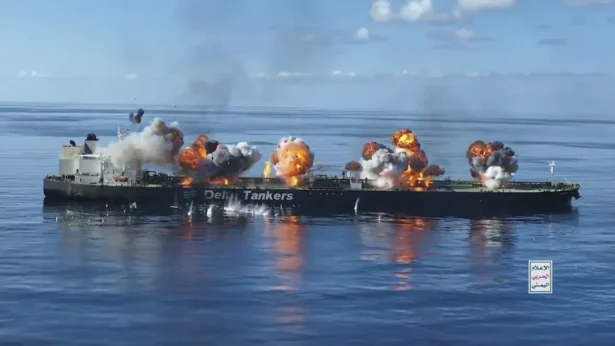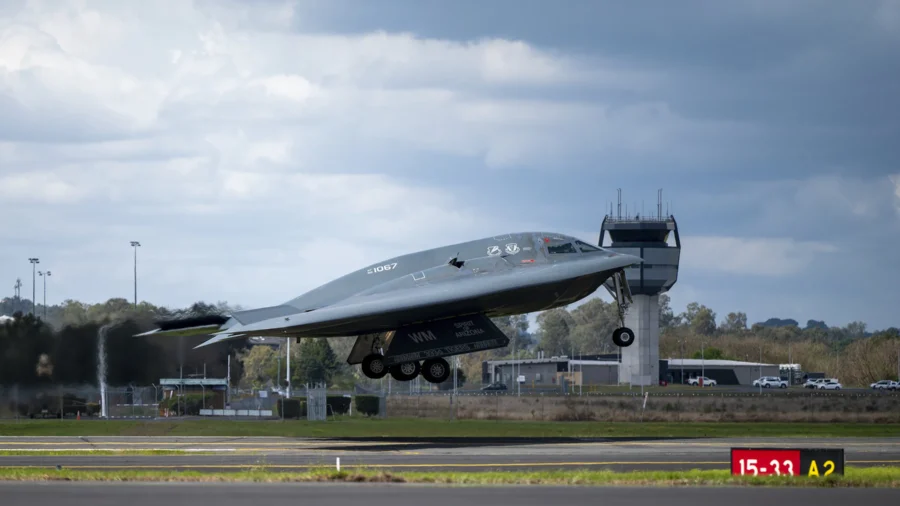The United States said on Wednesday it has launched bombing raids, using long-range B-2 Spirit stealth bombers, on underground bunkers used by Yemen’s Houthi rebels to store missiles and drones.
The U.S. Central Command (Centcom), said that it was assessing the damage inflicted by navy and air force pilots, and there was no indication of civilian casualties.
Defense Secretary Lloyd Austin said in a statement Oct. 16, “U.S. forces targeted several of the Houthis’ underground facilities housing various weapons components of types that the Houthis have used to target civilian and military vessels throughout the region.”
US Can Target ‘Anytime, Anywhere’
Centcom confirmed in a statement that U.S. Air Force B-2 Spirit long-range stealth bombers were involved and said, “The employment of the B-2 bomber demonstrates U.S. global strike capabilities to reach these targets, when necessary, anytime, anywhere.”
The Houthis’ main spokesman, Yahya Sare’e, who has an account on X, has not commented on the bombing raid.
Yemen, which is south of Saudi Arabia, is close to one of the busiest shipping channels in the world and the Bab al-Mandab Strait, which lies between Arabia and Africa, is a key pinchpoint.
The Houthis are a rebel movement—part of the Iran-led “axis of resistance”—drawn from northern Yemen’s Shiite Muslim Zaydi community.
Officially known as Ansar Allah (Partisans of God), they have controlled the Yemeni capital Sana’a and a swathe of territory in north and west Yemen since 2014.
Shortly after Hamas launched its Oct. 7, 2023 attacks on Israel, the Houthis have been firing missiles in the direction of Israel and at shipping in the Red Sea, which they claim is either heading to, or has stopped in, Israel.
The Houthis are estimated to have around 20,000 fighters in Yemen and possess thousands of missiles and drones, largely sourced from Iran or manufactured on the basis of Iranian designs.
Last month a Houthi missile triggered sirens across central Israel but landed in a field, without causing any casualties.
On Sept. 29, the day after another Houthi missile attack, the Israeli air force responded by bombing Houthi targets in the Yemeni port of Hodeida.
Earlier this month the U.S. military carried out 15 strikes against Houthi targets in Yemen, with residents reporting explosions at military outposts and an airport.
But it appears the Houthis have been storing missiles and other weapons deep underground, hence the need for the United States to target them with stealth bombers carrying so-called bunker-buster munitions.
‘Hardened Underground Facilities’
In their statement, the U.S. military said, “Centcom forces conducted multiple, precision airstrikes on numerous Iran-backed Houthi weapons storage facilities within Houthi-controlled areas of Yemen that contained various advanced conventional weapons used to target U.S. and international military and civilian vessels navigating international waters throughout the Red Sea and Gulf of Aden.”
“These actions were taken to degrade the Houthi’s capability to continue their reckless and unlawful attacks on international commercial shipping and on U.S., coalition, and merchant personnel and vessels in the Red Sea, Bab al-Mandeb Strait, and the Gulf of Aden, and to degrade their ability to threaten regional partners,” it added
The Centcom statement did not go into detail about the munitions used but said, “Centcom forces targeted the Houthi’s hardened underground facilities housing missiles, weapons components, and other munitions used to target military and civilian vessels throughout the region.”
Centcom said they would provide an update on the raid as soon as more information was available.
Satellite images will be analyzed in an attempt to assess whether the raids completed their task.
Among the munitions which may have been used is the BLU-109 Penetrator range of bombs, manufactured by General Dynamics. The largest of these is a 2,000-pound bomb.
Lockheed Martin’s laser-guided Paveway bomb has also been used in the past to damage underground bunkers in Iraq and elsewhere.
Earlier this week the United Nations special envoy for Yemen said the country was in danger of being dragged into the Israel-Iran conflict.

Hans Grundberg said the Houthi attacks shipping in the Red Sea, “have significantly increased the risk of an environment disaster.”
Grundberg and the U.N.’s acting humanitarian chief Joyce Msuya urged the Houthis to halt their attacks on shipping.
On Oct. 15, Grundberg said many Yemenis were working for peace but said, “Now, like many in the Middle East, their hopes for a brighter future are falling under the shadow of potentially catastrophic regional conflagration.”
A Houthi missile attack on the Greek-flagged oil tanker Sounion in August came close to causing a major oil spill in the Red Sea, with catastrophic environmental consequences.
Associated Press and Reuters contributed to this report.
From The Epoch Times

